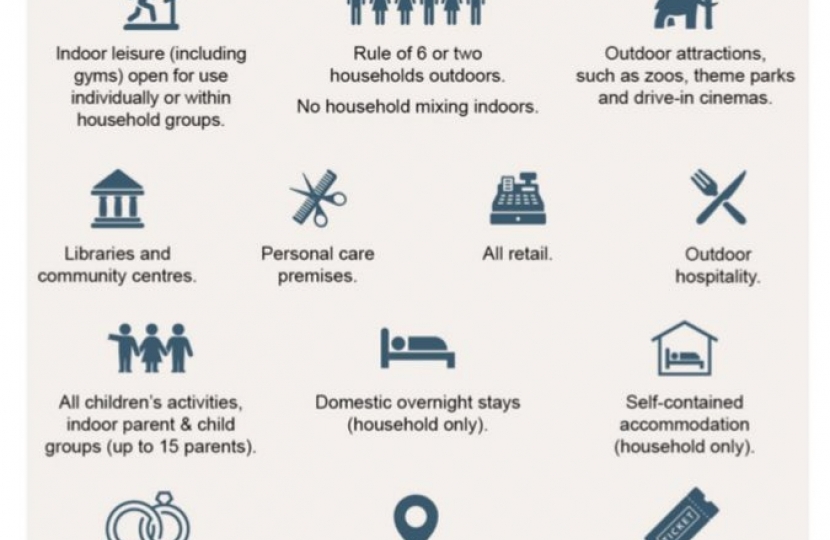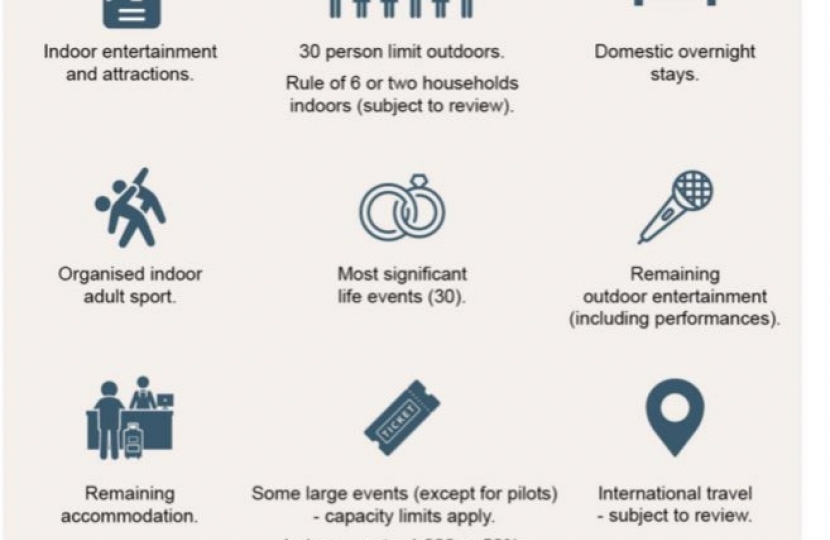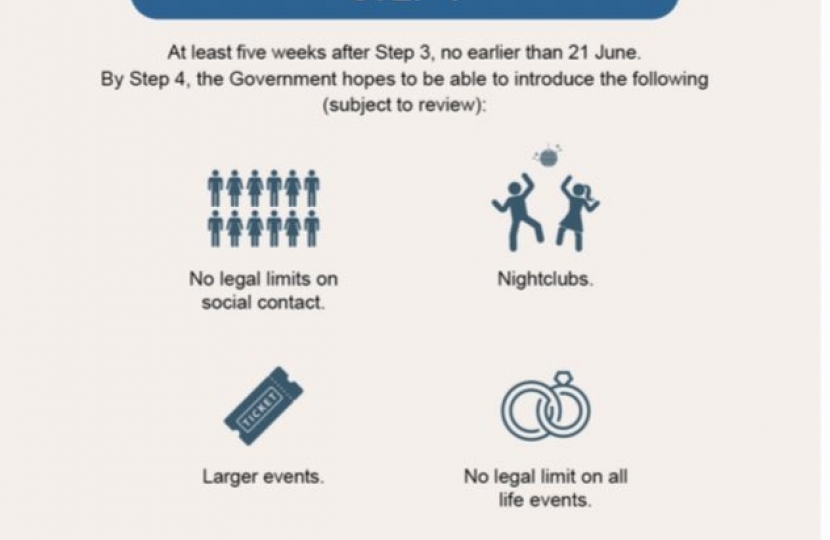The Prime Minister made a statement today in the Chamber of the House of Commons outlining our route out of lockdown.
From 8 March, people in England will see restrictions start to lift and the government’s four-step roadmap offer a route back to a more normal life. More information on the four steps in the images above and text below.
The success of the vaccination programme is one factor - so far over 17 million people have had their jabs - but by no means the whole story. The public have also risen to the challenge of suppressing COVID-19: by obeying the law; staying at home; getting tested when needed; isolating when required, and following the ‘hands, face, space’ and ‘letting fresh air in’ guidance.
While we must all remain vigilant - in particular against the threat from new COVID-19 variants - and continue to protect the NHS, a safe exit from lockdown can begin. It will take place in four steps; and at each step, we plan to lift restrictions across the whole of England at the same time.
In implementing this plan we will be guided by data, not dates, so that we do not risk a surge in infections that would put unsustainable pressure on the NHS. For that reason, all the dates in the roadmap are indicative and subject to change. There will be a minimum of five weeks between each step: four weeks for the scientific data to reflect the changes in restrictions and to be analysed; followed by one week’s advance notice of the restrictions that will be eased.
Only when the government is sure that it is safe to move from one step to the next will the final decision be made. The decision will be based on four tests: the vaccine deployment programme continues successfully; evidence shows vaccines are sufficiently effective in reducing hospitalisations and deaths in those vaccinated; infection rates do not risk a surge in hospitalisations which would put unsustainable pressure on the NHS; and our assessment of the risks is not fundamentally changed by new Variants of Concern.
The government will continue to protect the public by ensuring local outbreaks are managed quickly and effectively and that we combat new dangerous variants, both within the UK and at the border. The government will also continue to support families and businesses throughout the steps set out in the roadmap - details of which will be set out by the Chancellor in the Budget on 3 March.
Summary of the 4 step roadmap
8th March Step 1
- The safe return of all children and students to face-to-face education in schools and colleges.
- Introduction of twice-weekly rapid testing for secondary and college pupils - in addition to regular testing for all teachers - to reduce the chance of the virus spreading in schools.
- Higher Education students at English universities on practical courses can also return from 8 March.
- Childcare and children’s supervised activities can also resume where necessary to enable parents to work or engage in similar activities.
- People will be allowed to leave home for recreation and exercise outdoors with their household or support bubble, if they are eligible for one, or with one person from outside their household. Care home residents will also be allowed one regular visitor.
29th March
The evidence shows that it is safer for people to meet outdoors rather than indoors. And this is why from when most schools start to break up for the Easter holidays from 29th March, we will have the following changes:
- Outdoor gatherings (including in private gardens) of either 6 people (the Rule of 6) or 2 households will also be allowed, making it easier for friends and families to meet outside.
- Outdoor sports facilities such as tennis and basketball courts, and open-air swimming pools, will also be allowed to reopen, and people will be able to take part in formally organised outdoor sports.
- The ‘stay at home’ rule will end on 29 March but many restrictions will remain in place. People should continue to work from home where they can and minimise the number of journeys they make where possible, avoiding travel at the busiest times and routes.
- Travel abroad will continue to be prohibited, other than for a small number of permitted reasons. Holidays abroad will not be allowed, given it will remain important to manage the risk of imported variants and protect the vaccination programme. The government has launched a new taskforce to review global travel which will report on 12 April.
12th April at earliest Step 2
- Opening of non-essential retail; personal care premises such as hairdressers and nail salons; and public buildings, including libraries and community centres.
- Indoor leisure facilities such as gyms will also reopen (but only for use by people on their own or in household groups); as will most outdoor attractions and settings including zoos, theme parks, and drive-in cinemas.
- Self-contained accommodation such as campsites and holiday lets, where indoor facilities are not shared with other households, can also reopen.
- Hospitality venues will be allowed to open and to serve people outdoors and there will be no need for customers to order a substantial meal with alcoholic drinks and no curfew, although customers must order, eat and drink while seated (‘table service’).
- Wider social contact rules will apply in all these settings to prevent indoor mixing between different households.
- While funerals can continue with up to 30 mourners, the number of people able to attend weddings, receptions and commemorative events such as wakes will rise to 15.
17th May at earliest Step 3
At this stage, the government will look to continue easing limits on seeing friends and family wherever possible, allowing people to decide on the appropriate level of risk for their circumstances.
- Most legal restrictions on meeting others outdoors will be lifted - although gatherings of over 30 people will remain illegal.
- Indoors, the Rule of 6 or 2 households will apply - we will keep under review whether it is safe to increase this.
- As soon as possible and by no later than Step 3, we will also update the advice on social distancing between friends and family, including hugging. But until this point, people should continue to keep their distance from anyone not in their household or support bubble.
- Most businesses in all but the highest risk sectors will be able to reopen. In all sectors, COVID-Secure guidance will remain in place and businesses may not cater for groups bigger than the legal limits.
- Indoor hospitality will reopen - and as in Step 2, venues will not have to serve a substantial meal with alcoholic drinks; nor will there be a curfew. Customers will, however, have to order, eat and drink while seated.
- Indoor entertainment venues will be able to open up such as cinemas and children’s play areas; the rest of the accommodation sector, including hotels, hostels and B&Bs; and indoor adult group sports and exercise classes.
- The government will also allow some larger performances and sporting events in indoor venues with a capacity of 1,000 people or half-full (whichever is a lower number), and in outdoor venues with a capacity of 4,000 people or half-full (whichever is a lower number). In the largest outdoor seated venues, where crowds can be spread out, up to 10,000 people will be able to attend (or a quarter-full, whichever is lower).
- Up to 30 people will be able to attend weddings, receptions and wakes, as well as funerals. This limit will also apply to other types of significant life events including bar mitzvahs and christenings.
Finally, before Step 4 begins, the government will complete a review of social distancing and other long-term measures that have been put in place to cut transmission. This will inform decisions on the timing and circumstances under which the rules on 1 metre plus, the wearing of face coverings and other measures may be lifted. This will also inform guidance on working from home – which should continue wherever possible until this review is complete.
21st June at earliest Step 4
At this stage, the government hopes to be in a position to remove all legal limits on social contact.
- Reopen remaining premises, including nightclubs, and ease the restrictions on large events and performances that apply in Step 3. This will be subject to the results of a scientific Events Research Programme to test the outcome of certain pilot events through the spring and summer, where we will trial the use of testing and other techniques to cut the risk of infection.
- The same Events Research Programme will guide decisions on whether all limits can be removed on weddings and other life events.
As we move through each of these phases in the roadmap, we must all remember that COVID-19 remains a part of our lives. We are going to have to keep living our lives differently to keep ourselves and others safe. We must carry on with ‘hands, face, space’. Comply with the COVID-Secure measures that remain in place. Meet outdoors when we can and keep letting fresh air in. Get tested when needed. Get vaccinated when offered. If we all continue to play our part, we will be that bit closer to a future that is more familiar.
If you want to read about these steps and the government's approach in more detail, do have a look here and here.




